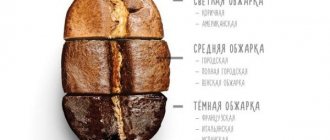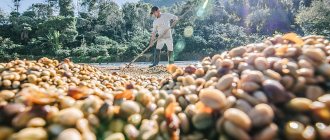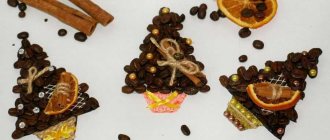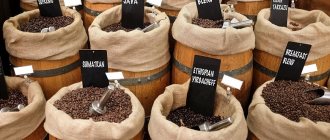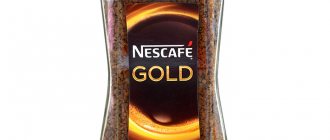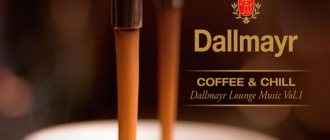Today I will tell you how to lightly roast green coffee beans (Arabica) in a regular frying pan on a gas stove. The article consists of several blocks. In each block I tell you what to do and why exactly.
I won’t tell you why you should roast coffee at home, but I can tell you why you shouldn’t do it. It is quite difficult to fry grain evenly and efficiently, and you most likely will not be able to do everything right the first time. Therefore, I strongly recommend choosing cheaper grains for your first roasting experiments. It would be a shame to ruin dear Colombia San Pascual.
Story
The first evidence of coffee roasting came to us from the Ottoman Empire and dates back to the 15th century, when thin round sheets of metal or porcelain were used as utensils. They were equipped with a long handle so that it was convenient to hold the “frying pan” over a brazier with coals, periodically shaking and stirring the grains.
Around 1650, a cylindrical roaster was invented in Cairo that could roast large batches of coffee. Soon the innovation was adopted in France, Holland, Italy and other European countries.
Cylindrical roasters for roasting coffee beans
In the 19th century, many commercial roasters were patented for mass roasting of coffee. At the same time, lovers of the invigorating drink continued to roast the grains by hand on baking sheets and stoves. For such enthusiasts, a home spherical roaster appeared in Ohio in 1849. However, by the 1900s, it became much more profitable to buy pre-roasted coffee: thanks to developing technologies, it cost only slightly more than raw coffee.
Related article: how to choose a roaster for your home.
In 1903 and 1906, electric roasters were patented in the USA and Germany, respectively, the problem of smoke affecting the taste of the product was solved. In 1976, they learned to fry grains with hot air without the risk of burning them into embers. Nowadays, there are many devices for roasting coffee, ranging from banal metal meshes that must be placed over an open fire, to high-tech “smart” devices.
The boom of coffee shops in the 1970s made home roasting of coffee beans almost meaningless, turning it into the lot of fine connoisseurs - commercial roasters installed in coffee shops allow you to quickly and efficiently roast beans to any degree, you can program the roasting style, while the barista does not must stay vigilantly at the stove and stir the coffee so that the beans do not burn.
Coffee bean roasting technology
Raw coffee beans are green in color. In principle, you can eat them this way - for example, add them to a salad or infuse them with strong alcohol, but they won’t make coffee as a drink.
The industrial roasting process is divided into the following stages: sorting, roasting, cooling, packaging.
When roasting, coffee beans change color first to yellowish, then to brown, double in size (but lose weight due to evaporated water), and acquire a characteristic aroma. If everything is done correctly, tannins will decompose in the beans, the fruits will no longer be so tart and astringent, B vitamins will be retained in them, caffeine will be formed (this substance is responsible for the taste and aroma characteristics of coffee), and essential oils will be released.
Roasting temperature varies from 200 to 250 degrees Celsius. The grains must be roasted evenly, so they must be stirred constantly. A heat that is too low will not allow the flavor to fully develop, while a heat that is too high will burn the outer layer of the grain, leaving the core raw.
In industrial conditions, finished roasted coffee is cooled with air, or less often with water. Cooling is necessary because if you leave the beans to cool naturally, they will continue to roast “from the inside” due to the temperature already reached.
Industrial roaster
At approximately 196°C the beans begin to crackle, this sound (“first pop”) marks the beginning of the light roasting phase. At 224°C, a “second pop” occurs, meaning that the previously expanding grains began, on the contrary, to dry out.
In some countries, a bit of local flavor is added to the classic process. For example, in Vietnam, raw coffee beans are brushed with butter and sprinkled with sugar, so that by the end of roasting they are caramelized.
After the First Pop, the grains acquire a roasted aroma. After the Second Cotton, essential oils begin to be released.
What to do next with grains
It is not enough to know how to roast coffee correctly; the quality of the drink depends on what is done with it next. After turning off the heat, you must immediately remove the coffee beans from the baking sheet or pan and cool. This is important because they will continue to heat up and may burn.
During industrial processing, they are cooled with a special fan or cold water. At home, you can simply pour the grains onto a cold metal surface in a thin layer. You should also try to remove the husks. To do this, they are poured into a colander or sieve.
There is not a single coffee lover who would not appreciate the benefits of the taste of a drink made from self-roasted beans. This is not difficult to do, if you take into account all the advice and recommendations of experts, you will get a truly tasty and aromatic product.
Brazil Mogiana
- 5
Brazil Santos
- 4.9
Guatemala El Transito
- 4.8
Kenya AA Baragwi Kamurandi
- 4.6
Nicaragua Maragogyp
- 4.8
Guatemala DECAFF (decaf)
- 4.6
India Robusta Cherry
- 4.2
Colombia Supremo
- 4.6
In order to make the taste even more refined and exotic, baristas add various spices to the drink made from brewed grains. The most “banal” additive, which is highly respected in eastern countries, is allspice. This piping hot coffee creates the atmosphere of the colorful and bustling Moroccan markets. Amazing places for a tourist, where the sun is shining directly overhead, the stone pavements are so narrow that you can’t pass each other, and the air is filled with the aroma of different spices.
Coffee roast levels
Weak (~ up to 205 °C). Dry grains are light brown in color with a sour taste without roasted notes; the individual characteristics of the variety are perfectly felt. Caffeine content 1.37%.
Medium (~ up to 219 °C). Dark brown grains, dry, sweet and sour taste, rich aroma. The drink is full-bodied, the acidity is muted. Caffeine content 1.31%.
Strong (~ up to 230 °C). Dark brown grains, with an oily film, almost no sourness, with a bitter-sweet taste, rich roasted aroma. The individual characteristics of the variety are almost not preserved. Caffeine content 1.31%.
Maximum (highest) (~ up to 245 °C). The color of the grains is black-brown, the taste is bitter, with a “smoke”.
Also, degrees of roasting are divided into “light” and “dark” (based on the color of the grain).
Types of coffee roasting
It is important to remember that the final taste and aroma properties of coffee are influenced by other factors besides roasting: the type and age of the beans, the region of their cultivation, storage method, etc.
During the roasting process, the chlorogenic acid contained in coffee decomposes into quinic and caffeic acid, and bitter chlorogenic acid lactones are simultaneously formed. During intense roasting, lactones decompose, resulting in the quintessence of bitterness - phenylindanes. Therefore, the more the coffee is roasted, the more intense the bitterness.
| Roasting degree | Temperature | Appearance of grains | Taste and aroma |
| Cinnamon Roast | +195 °C | Dry, light brown | Delicate, with the aroma of freshly baked bread and pronounced sourness |
| New England Roast, Light | +205 °C | Dry, slightly darker than in the previous case | There is still sourness, but without bread notes |
| American Roast | +210 °C | Dry, rich light brown color | Sourness combines with delicate bittersweet notes |
| City Roast | +220 °C | Dry, rich brown color | Bittersweet notes are felt more clearly, the sourness weakens. This roast is good for coffee tastings |
| Full City Roast | +225 °C | Rich brown color, with the first drops of oil on the surface | Shades of chocolate and caramel appear in the taste |
| Vienna Roast | +230 °C | Surface oily, color dark brown | The sourness disappears, the caramel tones become more intense |
| French Roast | +240 °C | Color – dark brown, more oil on the surface | Burnt tones are woven into caramel shades, and astringency appears. This roast is considered optimal for making espresso. |
| Italian Roast | +245 °C | The color is getting darker, there is more oil | The bitterness is felt more and more clearly. Roast suitable for espresso |
| Spanish Roast | +250 °C | Brown-black color, oily surface | Sharp bitter taste with notes of burnt coffee. Not all varieties can withstand this degree of roasting: some grains simply become charred. |
Roast markings from coffee producers
Each coffee manufacturer has its own roasting scale. Some simply indicate intensity with numbers from 1 to 5:
- 1 – Cinnamon (Light);
- 2 – American or Urban (Medium);
- 3 – Full city or Viennese (Medium-dark);
- 4 – Italian (Dark);
- 5 – French or Spanish (Very dark).
Other manufacturers distinguish 3 degrees:
- weak (usually corresponds to American or Urban);
- middle (Viennese);
- strong (French or Italian).
How to enjoy it at home
The great thing about French roast is that you can cook it any way you want and it will still taste great. Millions of people prepare their morning brew using an automatic coffee maker with satisfying results. Many others believe that for a French roast, nothing is more perfect than cooking it in a French press.
For those who have espresso machines, be sure to enjoy their latte or cappuccino made with freshly roasted French roast.
Without a doubt, French Roast has left an indelible mark on the world of coffee. This is likely one of the most popular methods on the planet, and for good reason. The next time you're at a coffee shop and the barista asks if you want French fries, confidently answer "Yes!"
If you find an error, please select a piece of text and press Ctrl+Enter.
Roasting coffee at home
At home, coffee can be roasted in a frying pan/grill, in an oven, in a popcorn machine, or in a special roaster. The first two methods are the cheapest and simplest, the latter are the most effective. In theory, even a microwave oven will do. In practice, this method has not proven itself to be the best, since the grains are roasted poorly and unevenly.
Methods:
- Frying pan or grill. Pros: fast, convenient, cheap. Cons: It is difficult to maintain an accurate temperature if roasting over an open fire - the smoke affects the taste of the grain.
- Oven. Pros: cheap. Cons: slow, difficult to achieve uniform roasting of coffee beans.
- Popcorn machine. Pros: simple, the beans are mixed automatically, it’s easy to achieve uniform roasting. Cons: not intended for roasting coffee (if it breaks, the warranty will not be valid), high price.
- Roaster. Pros: designed for roasting coffee, easy to use. Cons: expensive.
After the first pop, beans for weak light coffee are obtained. After the second – medium-roasted grains. If you want a deep roast, wait 30 seconds after the second pop.
Immediately after roasting, you need to cool the beans - this can be done by pouring the coffee into a colander and directing a stream of cold air at it.
The pan must be completely dry and clean
When coffee is roasted, carbon dioxide is released, a process that continues even after the beans have been removed from the heat. Therefore, freshly roasted beans should be allowed to sit for about 12 hours, and only then poured into a container or sent for grinding.
If too much gas accumulates in the coffee, the lid of the container may be knocked off, and the gas will negatively affect the taste of the drink. To fully “mature”, gain taste, body and aroma, the grains need about 24 hours. On the other hand, you shouldn’t forget about roasted grains for longer than a week either - the taste will become musty and stale.
Two claps
The word “cotton” refers to a special professional term denoting the stage of roasting the grains. At the beginning of the process, the color of the beans changes to light yellow with a change from the herbaceous smell to a specific coffee aroma. It is accompanied by the first pop - a clearly distinguishable crackling sound, which signals that the stage of active caramelization of sugar has begun and the release of essential oils. At this time, the oven maintains a temperature of +170°C.
The duration of frying directly affects the amount of oils released and the aroma of the product. The grains that have released the maximum amount of essential oils have the brightest aroma. This result can be achieved by waiting for the second clap. At this time, the grains become very dark, complete combustion of sugar occurs, releasing thick acrid smoke. The temperature in the oven rises to +230°C.
Important!!! Light-roasted coffee beans have a strong flavor and high acidity, while over-roasted beans have a burnt, charcoal flavor.
The specific processing time is individual for each variety. Different varieties require a certain temperature regime and cycle length. To achieve the optimal taste of the drink, several varieties of grains are mixed in different ratios, having undergone varying degrees of processing, and tasting is carried out.
